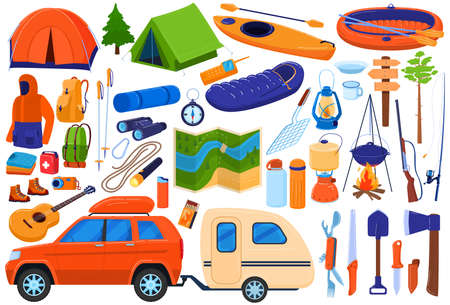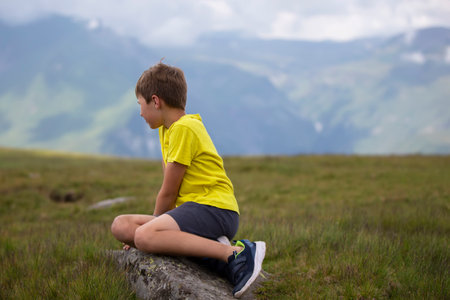1. Nature Exploration and Outdoor Skills
Camping is the perfect opportunity to help kids connect with nature while learning practical outdoor skills that build confidence and independence. Through fun, hands-on activities, children can discover the wonders of the natural world and develop a deeper appreciation for it.
Explore the Outdoors
Start with simple nature walks around your campsite or nearby trails. Encourage kids to observe their surroundings—look at different types of trees, listen to birdsong, or spot animal tracks. Bring along a magnifying glass or binoculars to make things more exciting and interactive.
Nature Scavenger Hunt
A scavenger hunt is a great way to turn exploration into a game. Create a list of items for your child to find, hear, or smell in nature. Heres a sample list you can use:
| Item | Description |
|---|---|
| Pinecone | Look near pine trees on the forest floor |
| Animal Tracks | Search in soft dirt or mud near water sources |
| Feather | Often found on trails or under trees |
| Moss or Lichen | Grows on rocks, tree trunks, or damp areas |
| Birdsong | Pause and listen—can you identify which bird? |
Learn Basic Survival Skills
Introducing kids to basic survival techniques not only teaches them useful life skills but also makes them feel capable in the wild. Keep it simple and age-appropriate:
- Map Reading & Compass Use: Show how north is marked and how to orient a map. Let them navigate a short trail using landmarks.
- Knot Tying: Teach easy knots like the square knot or bowline, which are useful for setting up tents or securing gear.
- Shelter Building: Use sticks, leaves, and tarps to create a simple lean-to shelter together as a family activity.
- Safe Fire Basics: Explain fire safety rules and show how to gather tinder and kindling (only if allowed at your campsite).
Identify Local Plants and Animals
Learning about plants and animals helps kids understand ecosystems and respect wildlife. Bring along a field guide specific to your camping region or download an app like Seek by iNaturalist.
Tips for Plant and Animal Identification:
- Take photos instead of picking plants—some may be protected species.
- Teach kids never to touch mushrooms or berries unless youre absolutely sure theyre safe.
- Look for animal signs like nests, burrows, droppings, or scratch marks on trees.
The more kids explore, the more curious they become about the world around them. By combining fun with learning, youll give them outdoor experiences that leave lasting memories—and valuable skills theyll carry for life.
2. Creative Arts and Crafts in Nature
Camping is the perfect time to spark your child’s imagination with nature-inspired arts and crafts. With so many natural materials all around—like leaves, pinecones, sticks, rocks, and flowers—kids can explore their creativity while learning about the environment.
Fun Craft Ideas Using Natural Materials
These hands-on activities are not only fun but also encourage kids to observe and appreciate the beauty of nature. Here are a few creative projects you can try at your campsite:
| Craft Activity | Materials Needed | Description |
|---|---|---|
| Nature Collage | Leaves, twigs, bark, glue, paper or cardboard | Let kids collect items from around the campsite and arrange them into a beautiful collage. |
| Painted Stones | Smooth rocks, non-toxic paint or markers | Find flat stones and let kids paint animals, patterns, or messages on them. |
| Pinecone Bird Feeders | Pinecones, peanut butter, birdseed, string | Spread peanut butter on a pinecone, roll it in birdseed, and hang it from a tree branch. |
| Leaf Rubbings | Paper, crayons or colored pencils, leaves | Place a leaf under paper and rub over it with crayons to reveal its texture and shape. |
Why It Matters
These simple crafts help children develop fine motor skills and artistic expression while teaching them to value and protect the natural world. By using items found in nature rather than store-bought supplies, kids learn resourcefulness and sustainability in a fun way.
Pro Tip for Parents:
Bring along some basic art supplies like glue sticks, scissors (kid-safe), tape, and markers in a small craft box. This way youre always ready for spontaneous creativity during downtime at camp.

3. Campfire Stories, Songs, and Skits
Gathering around the campfire is one of the most magical parts of any camping trip. Its more than just roasting marshmallows—its a time to connect, laugh, and learn together as a family. Sharing stories, singing songs, and performing skits are fun ways to help children grow in confidence, improve their communication skills, and create memories that last a lifetime.
Campfire Stories
Storytelling encourages imagination and listening skills. Kids can take turns telling made-up tales or recalling family memories. You can also bring along a book of age-appropriate spooky or silly campfire stories.
Tips for Campfire Storytelling:
- Let kids lead: Encourage them to invent their own stories.
- Use prompts: Start with “Once upon a time…” or “In the deep woods…” to spark creativity.
- Add sound effects: Use sticks, rocks, or your voice to make it more exciting.
Songs Around the Fire
Singing together is a great way to build group spirit. Choose simple, classic campfire songs that everyone can join in on—even little ones!
Popular Campfire Songs for Kids:
| Song Title | Description |
|---|---|
| “The Ants Go Marching” | A fun counting song with movements for younger children. |
| “This Land Is Your Land” | A patriotic tune perfect for American camping trips. |
| “Boom Chicka Boom” | A call-and-response song that lets kids be silly and loud! |
| “Shell Be Coming Round the Mountain” | A classic folk song that’s easy to sing along with. |
Campsite Skits
Campsite skits are mini plays that kids can plan and perform using nature as their stage. They promote teamwork and creativity while giving everyone a chance to shine.
Simple Skit Ideas:
- The Lost Explorer: One camper pretends to be lost in the woods while others act as forest animals offering silly advice.
- The Talking Tree: A tree (played by someone with branches) gives out funny wisdom to other campers.
- A Day at Camp Gone Wrong: A humorous take on common camping mishaps like burnt hotdogs or missing socks.
No matter which activity you choose—singing, storytelling, or skits—the goal is to have fun together. These traditions not only entertain but also strengthen bonds among family members around the warm glow of the campfire.
4. Fun Physical Activities and Outdoor Games
Camping is the perfect opportunity to get kids moving and enjoying the great outdoors. Physical activities and games not only help burn off energy but also teach valuable skills like teamwork, coordination, and problem-solving. Here are some fun and active games that will keep children engaged while making the most of your camping trip.
Classic Camping Games
Many outdoor games have stood the test of time because they’re simple, fun, and easy to set up with little to no equipment. Here are a few favorites:
| Game | Description | Skills Developed |
|---|---|---|
| Scavenger Hunt | Create a list of natural items for kids to find around the campsite, like pinecones, feathers, or certain leaves. | Observation, problem-solving, nature awareness |
| Flashlight Tag | A nighttime twist on traditional tag—one player uses a flashlight to “tag” others by spotting them in the beam. | Agility, stealth, listening skills |
| Nature Races | Set up short races using natural paths or trails. Add challenges like hopping over sticks or ducking under branches. | Balance, speed, coordination |
| Obstacle Course | Use logs, rocks, ropes, or other safe objects to create a mini obstacle course at your campsite. | Strength, balance, strategic thinking |
Team-Building Challenges
If youre camping with multiple families or a group of kids, try organizing team-based activities. These help kids learn how to communicate and work together effectively:
- Tug-of-War: Use a sturdy rope and mark lines in the dirt. Great for building strength and team spirit.
- Sack Races: Bring pillowcases or burlap sacks for classic hop races that always bring laughs.
- Relay Races: Set up stations for tasks like filling water cups or carrying pinecones from one end to another.
Tips for Success
- Always check the area for safety hazards before starting any physical activity.
- Adapt games based on age groups so everyone can participate comfortably.
- Encourage good sportsmanship and teamwork rather than competition.
These outdoor games provide more than just entertainment—they help kids stay healthy, build relationships with others, and connect more deeply with nature during their camping adventure.
5. STEM Learning in the Wilderness
Camping is a perfect opportunity to introduce your kids to the wonders of STEM—science, technology, engineering, and math—through hands-on outdoor activities. These fun experiments not only keep children engaged but also spark curiosity and encourage problem-solving skills.
Outdoor STEM Activities for Kids
Here are a few simple and educational activities you can try with your children while camping:
| Activity | STEM Focus | What You Need | What Kids Learn |
|---|---|---|---|
| Make a Sundial | Science & Math | Sticks, rocks, sunlight, watch or phone for time reference | Understanding how the sun moves and how time was measured before clocks |
| Study Bugs with Magnifiers | Biology & Observation Skills | Magnifying glass, bug containers (optional) | Insect anatomy, habitats, and classification |
| Track Animal Footprints | Zoology & Critical Thinking | Notebook, pencil, footprint guide (or use a phone app) | Identifying animals by their tracks and learning about their behaviors |
| Build a Mini Dam with Rocks | Engineering & Problem-Solving | Rocks, mud, small stream or water source (if safe) | Water flow control, structural stability, teamwork |
Tips for Successful STEM Exploration Outdoors
- Keep it simple: Use natural materials and tools you already have.
- Let kids take the lead: Encourage them to ask questions and test ideas.
- Make it playful: Turn experiments into games or mini challenges.
- Tie it to real life: Show how science and engineering are part of everyday camping.
The great outdoors offers endless possibilities for STEM learning. With a little creativity and curiosity, your kids will walk away from your camping trip with both new knowledge and unforgettable memories.
6. Environmental Awareness and Stewardship
Camping is a perfect opportunity to teach kids how to care for the environment while having fun outdoors. By introducing them to eco-friendly habits and the Leave No Trace principles, youre helping raise future nature lovers who understand the importance of protecting our planet.
Teach the Leave No Trace Principles
The Leave No Trace principles are a great way to help children learn how to minimize their impact on nature. These seven simple rules can be explained in a fun and age-appropriate way:
| Principle | Kid-Friendly Explanation |
|---|---|
| 1. Plan Ahead and Prepare | Know where youre going and what youll need. |
| 2. Travel and Camp on Durable Surfaces | Stick to trails and campsites so you don’t hurt plants. |
| 3. Dispose of Waste Properly | Pack out your trash—leave nothing behind! |
| 4. Leave What You Find | Don’t take rocks or flowers—take pictures instead. |
| 5. Minimize Campfire Impact | Use small fires or camp stoves safely. |
| 6. Respect Wildlife | Watch animals from afar—don’t feed or scare them. |
| 7. Be Considerate of Others | Keep noise down and share the outdoors with everyone. |
Eco-Friendly Camping Activities for Kids
You can make environmental learning enjoyable by turning it into hands-on activities during your trip:
- Trash Clean-Up Challenge: Give each child a small bag and turn picking up litter into a game. See who can collect the most trash around your campsite or along a trail (safely, of course!).
- Nature Scavenger Hunt: Create a list of natural items to find—like pinecones, feathers, or animal tracks—but remind kids not to pick anything up, just observe!
- Tiny Conservation Projects: Help children build bird feeders from recycled materials or plant native seeds if allowed in the area.
- Sustainable Habits: Show kids how to use reusable water bottles, sort recyclables, and avoid single-use plastics during camping trips.
Create an “Earth Hero” Badge System
Make environmental responsibility exciting by creating badges or stickers that children can earn during your camping trip. Heres a simple example:
| Badge Name | Description |
|---|---|
| Litter Legend | Picks up at least five pieces of trash responsibly. |
| Wildlife Watcher | Keeps distance while observing animals quietly. |
| Tidy Camper | Keeps their camp area clean and organized. |
| Sustainability Star | Makes eco-friendly choices like using reusable gear. |
Simple Conversations That Make a Difference
You don’t need to give long lectures—just take time during a hike or meal to talk about why its important to protect nature. Ask questions like, “What do you think would happen if everyone left trash here?” or “How do you think animals feel when people get too close?” These small conversations can spark big ideas in young minds.
The Goal: Inspire Lifelong Responsibility
The goal is to create memories that also build awareness. When children learn that they can be protectors of nature, it gives them confidence and pride. These lessons stick with them long after the tent comes down—and thats something truly special about camping together as a family.


